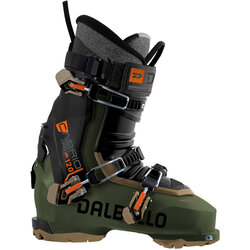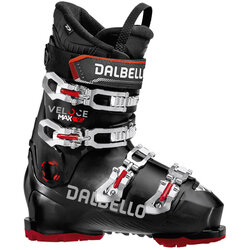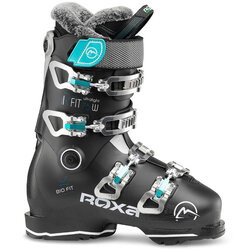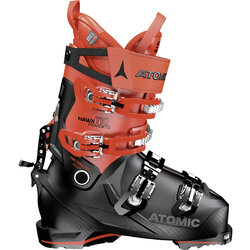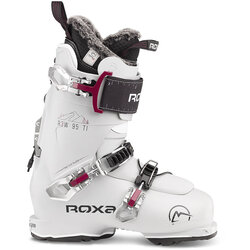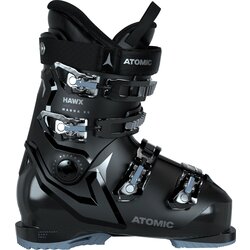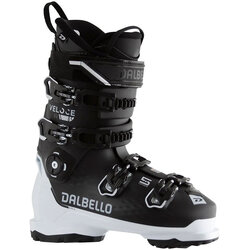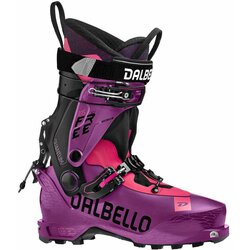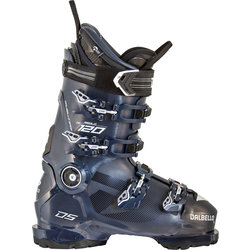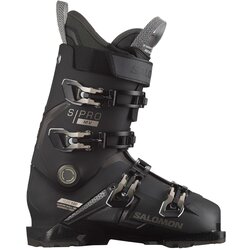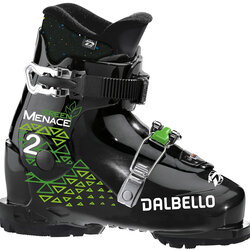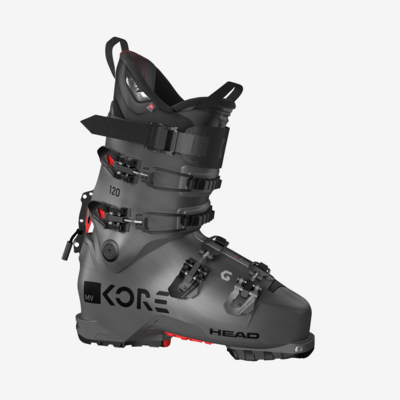
How to Choose the Perfect Ski Boots
A Comprehensive Buying & Sizing Guide
Skiing demands precision and control. Among the equipment needed to ski, boots play a pivotal role, acting as the interface between your body and the skis. And for most of us, when it comes to boots, comfort that still allows for precise driving of the skis and a feeling for security and control is key. Selecting the right pair of boots involves understanding your skiing style, foot anatomy and shape, and individual preferences. In this detailed guide, we will navigate the intricate world of ski boots, exploring every aspect to ensure you make an informed decision.
Choosing Boots by Skier Type & Ability
Check out the chart below. Think about where you slot in on this spectrum. From there you have a ballpark for fit, flex and features Check out the descriptions below the chart for more details about the three ability levels we have included here.
| Ability | Beginner - Intermediate | Intermediate - Advanced | Advanced - Expert |
|---|---|---|---|
| Style | Cautious | Average - Confident | Aggressive |
| Speed | Slow | Medium – Fast | Very Fast |
| Terrain | Bunny Slope / Groomers | Fast Groomers / All Mountain / Park and Pipe / Off-Piste | All Mountain / Park and Pipe / Off-Piste / Steeps / Cliffs / Race |
| Fit | Indicated Size or 1/2 size larger | Indicated size or 1/2 size smaller | 1/2 to 1 size smaller than indicated |
| Flex Index | Men's 60-80, Women's 50-60 | Men's 80-110, Women's 60-90 | Men's 110-130, Women's 90-110 |
Determining Size, Flex and Width
Ski boots are sized using the Mondopoint scale, based on the length of your foot in centimeters. It is vital to measure your foot accurately, ensuring a snug fit without compromising circulation. While using conversion charts like the one below can be helpful, we recommend having your foot sized at a reputable shop (like ours!). A well-fitting boot minimizes discomfort and enhances your skiing experience.
| US MENS / UNISEX US | WOMENS (US) | MONDO POINT |
|---|---|---|
| 8 (Kids) | - | 15.5 |
| 9-10 (Kids) | - | 16.5 |
| 10-11 (KIDS) | - | 17.5 |
| 11-12 (KIDS) | - | 18.5 |
| 12-13 (KIDS) | - | 19.5 |
| 1-2 | - | 20.5 |
| 2-3 | - | 21.5 |
| 3-4 | 5 | 22.5 |
| 4-5 | 5-6 | 23.5 |
| 5-6 | 6-7 | 24.5 |
| 7-8 | 8-9 | 25.5 |
| 8-9 | 9-10 | 26.5 |
| 9-10 | 10-11 | 27.5 |
| 10-11 | 11-12 | 28.5 |
| 11-12 | - | 29.5 |
| 12-13 | - | 30.5 |
| 13-14 | - | 31.5 |
How to measure for your feet to determine your mondopoint size
Start by placing your heel against a vertical surface, like a wall. Measuring the distance from the wall to the end of your longest toe in centimeters or inches. If your ruler measures inches, simply multiply the length of your foot in inches by 2.54 to convert to centimeters. Once you have the length of your foot in centimeters (example 27.5 cm, or 10.825 x 2.54), you can say that your mondopoint size would be 27.5.
Beginner / Intermediate Skiers |  |
Generally speaking, beginner-intermediate skiers should by trying on a that is boot close to their measured mondopoint size or up to one full size bigger if need be. The key to deciding on the final size you choose in a boot comes down to how you try on the boots and evaluate the fit. Check out our guide to trying on skis boots for more on that. Also, the liner of the boot will compress, or “pack-out” after just a few ski outings increasing the room in the boot. As far as flex, error on the side of a softer flex boot - 60-80 flex rating. This will allow for easier turn initiation and reduce discomfort on your shins caused by the upper cuff. Unless your feet are measured on a Brannock Device as being truly “narrow” for their length, look for boots that have a medium or average width last - +/-100mm.
Intermediate / Advanced Skiers |  |
We recommend choosing a boot that is as close as possible to your measured mondo size (or slightly shorter), but in a stiffer flex - 90-110 for men and 65-80 for women. Choose a last width that offers a snug fit.
Advanced / Expert Skiers |  |
Choose a shell size 1/2 to a full size smaller than their indicated size for a super precise and responsive fit, and a stiff or very stiff flex - 110-130. Also choose a last width that offers a snug fit.
The ski industry’s little secret
Ski boot manufacturers don’t make boot shells in half sizes. So a 26.0 and 26.5 boot normally use the exact same shell - if you try on a 26.5 boot and it feels too big, the next size down will be a 25.5, not a 26.0. Sometimes manufacturers will make the liners for the full and half size differently, or use different insoles, but more commonly the two sizes are identical except for the sticker on the boot.
Determining the Best Flex Rating
A boot’s flex rating, or flex index, is an indication of how difficult it is to flex or move the upper cuff forward when you lean forward in the boot and can range from soft (50) to very stiff (130). A boot’s flex index is almost always part of the name of the boot just as with a ski’s waist width. The boot’s flex rating is usually printed on the outside of the boot as well. It is important to know that there is no standard in the ski industry for determining the flex index of ski boots. One manufacturer’s 100 flex boot may be stiffer or softer than that of another manufacturer. So don’t get hung up on flex ratings. Use them as a guide to characterize boots as being soft, medium or stiff.
Flex Ranges for Men
| Ability | Beginner – Intermediate | Intermediate - Advanced | Advanced - Expert |
|---|---|---|---|
| Flex Rating | 60-80 | 80-110 | 110-130 |
| Feel | Soft | Medium | Stiff |
Considerations for women when it comes to boot flex Women tend to have a lower body mass for their height and foot size than men. So their flex ratings tend to skew lower.
| Ability | Beginner – Intermediate | Intermediate - Advanced | Advanced - Expert |
|---|---|---|---|
| Flex Rating | 50-60 | 60-90 | 90-110 |
| Feel | Soft | Medium | Stiff |
Beginner / Intermediate Skiers (Flex: Soft to Medium) |  |
As a beginner or intermediate skier, comfort and forgiveness are key. Opt for boots with a softer to medium flex rating. These boots facilitate easy turns and offer a forgiving nature, allowing you to focus on mastering basic techniques. Look for additional padding and cushioning for enhanced comfort during your learning phase.
Intermediate / Advanced Skiers (Flex: Medium) |  |
Intermediate to advanced skiers seek versatility. Boots with a medium flex provide the right balance between control and comfort. They are ideal for exploring varied terrains, offering precise steering capabilities. Look for customizable features like adjustable buckles and liners, allowing you to fine-tune the fit according to your preferences.
Advanced / Expert Skiers (Stiff to Very Stiff) |  |
Expert skiers demand high-performance boots. Stiff to very stiff flex ensures immediate responsiveness and maximum control, even on challenging slopes. These boots offer exceptional precision, allowing expert skiers to navigate through diverse snow conditions with confidence. Expert-level boots often come with advanced customization options, catering to the unique needs of professional skiers.
Determining the Best Last Width
The last width of a boot is an indication of the widest dimension of the inside of the boot. This point corresponds to where metatarsal heads of the foot, the balls of feet, will typically land in a properly sized boot. There are generally three ranges for last widths that the manufacturers use - narrow (97-98mm), medium (+/-100mm) and wide (102-106mm). Boots with wider forefoot measurements will typically be higher volume boots in general, with increased room elsewhere in the boot.
Other Ski Boot Features and Customization
Liners
The boot’s liner, the soft inner layer, provides insulation and cushioning. Liners in most boots today are thermo-moldable, offering customization options. These liners are heated and molded to your foot’s contours, speeding up the break-in or packing-out process. Customized liners provide improved comfort from ski outing #1 and help to prevent fatigue.
Buckles and Cuffs
Micro-adjustable buckles and cuffs enable personalized adjustments. Micro-adjustable buckles allow incremental tightening, ensuring a secure fit without undue pressure. Adjustable cuffs accommodate various leg shapes, enhancing comfort and control. Look for boots with multiple buckle points and adjustable cuff alignments, allowing you to tailor the fit according to your specific needs. A well-fitted cuff enhances support, preventing leg fatigue and optimizing your skiing performance.
Power Straps
Power straps, located at the top of the cuff, offer additional support. They secure the leg, minimizing vibrations and enhancing control. Adjustable power straps accommodate various leg sizes, ensuring a snug fit.
Boot Features for Diverse Terrain
Walk Modes
All-terrain or AT skiing involves traversing unmarked and challenging terrain. Boots with a walk mode facilitate mobility during uphill climbs. In walk mode, the rear of the cuff releases, allowing natural ankle movement. This mobility enhances comfort during ascents, combining the benefits of alpine and touring boots. Walk mode boots are essential for backcountry enthusiasts, offering convenience and versatility in varying terrains.
Traction Soles
Ski boots with traction soles feature rubberized outsoles, providing enhanced grip on icy or rocky surfaces. Traditional ski boot soles lack traction, making walking on slippery terrain precarious. Traction soles, often found in hybrid alpine-touring boots, offer security while navigating icy slopes or rocky ridges. Consider boots with robust rubber soles, ensuring reliable grip during off-piste adventures.
How to purchase ski boots online: Tips and Recommendations
If you purchase your new boots online, follow our steps here for evaluating the fit of the boots. Don’t react to how the boot feels when you first put it on. In our stores, when a customer says “These feel small”, we say “Right answer”. There's no doubt they will feel snug and tight compared to your running shoes. But follow our try-on process before passing judgment.

